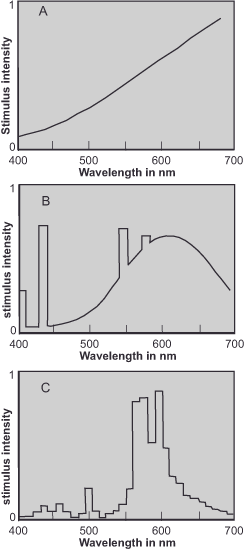You are here: Nature Science Photography – Lightness and color – The reproduction of lightness and color
In optics and lighting technology, metamerism (Greek meta – after, in the middle of, and meros – part, i.e., „consisting of several segments“) refers to the value of the color difference between two samples under two different light sources. Two or more objects are metameric if they elicit the same color perception under different spectra; two colors that are conditionally the same are metameric if they look the same under a particular type of light.
However, as the American saying goes, „As with all good things in life, there is no free lunch!“ The disadvantage of metamers is that they are just spectrally different in composition, so they have different remission curves. Thus, the degree of equality of reproduction and original depends on the quality of illumination. How can this be, you ask? Well, recall briefly the color constancy and our finding that it is not complete. We used the example of a green object whose remission curve we analyzed once under white illumination and once under the red excess light of sunset. In the second case, we had to assert that a clearly visible red component superimposed the still-recognizable green. The object’s reflective properties and illumination spectral composition caused this. Metamers suffer from something very similar.
To predict the color impression of an object with any remission curve, we need only multiply it by the intensity distribution curve of the light source. The result tells us how the absorption and reflection properties of the object deal with the incident spectrum. Figure 3 (2-3-intensity-distribution-curves) Intensity distribution curves illustrates this in three small graphs.
With this knowledge in mind, it is easy to imagine that two color samples, which appear identical under a standardized white light, lose this similarity when we change the illumination to a neon tube, which is also white. Fig. 47 shows how different the intensity distribution curves of different white light sources are.

But that’s not all; daylight also has different qualities at different times. The northern sky reflects light with an excess of blue. The dominant wavelength of direct sunlight is in the green range, and the light from the low sun in the morning and evening has a strong red component. Nevertheless, daylight always appears white to us (see „Constant color perception„).
Thus, two colors appear virtually identical under one illumination but differ to a greater or lesser degree under another. This connection holds significant relevance for our understanding of perception and photography: we can only achieve a match between the original and reproduction in a relatively wide range of lighting conditions. However, since today’s dyes effectively address this issue, the problem is actually confined to sophisticated illuminations such as older neon tubes, halogen spotlights, or colored bulbs. In practical terms, adjusting the reproduction to a medium daylight quality suffices. The printing industry equips sampling workstations with lighting consoles that adjust to the average daylight temperature of 5000 Kelvin. The fluorescent tubes used there also emit light with a spectral composition similar to natural daylight. We refer to this as the color rendering index, standardizing it to values ranging from zero to one hundred. The light temperature alone only indicates which temperature level of the black body heated for calibration a certain light resembles. When comparing digital originals and physical reproductions, set CRT and TFT monitors to a color temperature that matches the white of the paper.
However, if we view a print under different lighting conditions and notice slight differences in color, this is not due to metamerism. Rather, in this case, the scenario described at the beginning and our not 100% color consistency come into play: if we change the lighting, our color perception also changes a little. After all, this is based on the reflected wavelength stimulus, which in turn is the product of the object’s reflectance curve and the light source’s intensity distribution curve. This is completely normal, and that is why our images, no matter how we reproduce them, cannot look absolutely identical under all lighting conditions.
Next Analog image carriers – negative film
Main Lightness and Color
Previous Color Management – The Perception Algorithms of Machines
If you found this post useful and want to support the continuation of my writing without intrusive advertising, please consider supporting. Your assistance goes towards helping make the content on this website even better. If you’d like to make a one-time ‘tip’ and buy me a coffee, I have a Ko-Fi page. Your support means a lot. Thank you!


 Since I started my first website in the year 2000, I’ve written and published ten books in the German language about photographing the amazing natural wonders of the American West, the details of our visual perception and its photography-related counterparts, and tried to shed some light on the immaterial concepts of quantum and chaos. Now all this material becomes freely accessible on this dedicated English website. I hope many of you find answers and inspiration there. My books are on
Since I started my first website in the year 2000, I’ve written and published ten books in the German language about photographing the amazing natural wonders of the American West, the details of our visual perception and its photography-related counterparts, and tried to shed some light on the immaterial concepts of quantum and chaos. Now all this material becomes freely accessible on this dedicated English website. I hope many of you find answers and inspiration there. My books are on